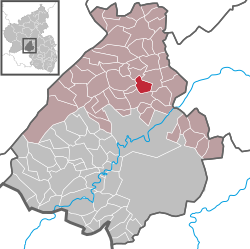Herrstein
| Herrstein | ||
|---|---|---|
|
||
| Coordinates: 49°46′46″N 07°20′19″E / 49.77944°N 7.33861°ECoordinates: 49°46′46″N 07°20′19″E / 49.77944°N 7.33861°E | ||
| Country | Germany | |
| State | Rhineland-Palatinate | |
| District | Birkenfeld | |
| Municipal assoc. | Herrstein | |
| Government | ||
| • Mayor | Reiner Schäfer | |
| Area | ||
| • Total | 4.79 km2 (1.85 sq mi) | |
| Elevation | 320 m (1,050 ft) | |
| Population (2015-12-31) | ||
| • Total | 848 | |
| • Density | 180/km2 (460/sq mi) | |
| Time zone | CET/CEST (UTC+1/+2) | |
| Postal codes | 55756 | |
| Dialling codes | 06785 | |
| Vehicle registration | BIR | |
| Website | www.vg-herrstein.de | |
Herrstein is an Ortsgemeinde – a municipality belonging to a Verbandsgemeinde, a kind of collective municipality – in the Birkenfeld district in Rhineland-Palatinate, Germany. It is the seat of the like-named Verbandsgemeinde
The municipality lies in the Hunsrück south of the Idar Forest on the Deutsche Edelsteinstraße (“German Gem Road”) in the Naheland, roughly 10 km north of Idar-Oberstein. The Fischbach flows through the village.
Also belonging to Herrstein are the outlying homesteads of Lindenhof, Steinäckerhof and Walkmühle.
Herrstein owes its beginnings to the crags at which a little stream called the Dietersbach emptied into the Fischbach, which seemed like a good place to build a castle to watch over the lordly holdings near Niederwörresbach, from which Herrstein was at first administered. At the foot of this stronghold on the so-called Herren-Stein (“Lord’s Stone”) arose a village, as so often happened when a castle was built in the Middle Ages. The castle and the village belonged then to the Counts of Sponheim, and Herrstein grew in importance as the seat of a Sponheim Oberamtmann
The exact time when the village was first settled is lost in the mists of history, but on 9 April 1279, Herrstein had its first documentary mention along with a knight named Ruther von Heresteyn. The Count of Sponheim eventually granted this slowly developing village town and market rights in 1428, although there was still sometimes compulsory labour, and the townsmen were also obliged to do maintenance on the town wall.
It is unknown whether these town fortifications arose before town rights were granted or only afterwards, but whatever the case, they only afforded the inhabitants protection from attack, and thereby also only offered any incentive to settle here, until firearms were developed. In the 17th and 18th centuries, they had rather the opposite effect to the originally intended one, provoking enemies’ attacks instead, for it was believed that the town must harbour considerable booty. It was the Herrsteiners themselves who actually knocked parts of their girding wall down in 1674 when the enemy was making his way through the country.
...
Wikipedia



